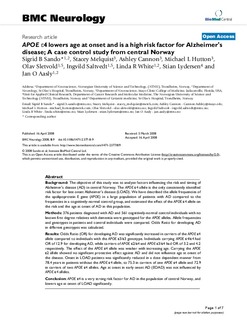APOE ε4 lowers age at onset and is a high risk factor for Alzheimer's disease; a case control study from central Norway
Sando, Sigrid Botne; Melquist, Stacey; Cannon, Ashley; Hutton, Michael; Sletvold, Olav; Saltvedt, Ingvild; White, Linda; Lydersen, Stian; Aasly, Jan
Journal article, Peer reviewed
Permanent lenke
http://hdl.handle.net/11250/2353209Utgivelsesdato
2008Metadata
Vis full innførselSamlinger
Sammendrag
Background: The objective of this study was to analyze factors influencing the risk and timing of
Alzheimer's disease (AD) in central Norway. The APOE ε4 allele is the only consistently identified
risk factor for late onset Alzheimer's disease (LOAD). We have described the allele frequencies of
the apolipoprotein E gene (APOE) in a large population of patients with AD compared to the
frequencies in a cognitively-normal control group, and estimated the effect of the APOE ε4 allele on
the risk and the age at onset of AD in this population.
Methods: 376 patients diagnosed with AD and 561 cognitively-normal control individuals with no
known first degree relatives with dementia were genotyped for the APOE alleles. Allele frequencies
and genotypes in patients and control individuals were compared. Odds Ratio for developing AD
in different genotypes was calculated.
Results: Odds Ratio (OR) for developing AD was significantly increased in carriers of the APOE ε4
allele compared to individuals with the APOE ε3/ε3 genotype. Individuals carrying APOE ε4/ε4 had
OR of 12.9 for developing AD, while carriers of APOE ε2/ε4 and APOE ε3/ε4 had OR of 3.2 and 4.2
respectively. The effect of the APOE ε4 allele was weaker with increasing age. Carrying the APOE
ε2 allele showed no significant protective effect against AD and did not influence age at onset of
the disease. Onset in LOAD patients was significantly reduced in a dose dependent manner from
78.4 years in patients without the APOE ε4 allele, to 75.3 in carriers of one APOE ε4 allele and 72.9
in carriers of two APOE ε4 alleles. Age at onset in early onset AD (EOAD) was not influenced by
APOE ε4 alleles.
